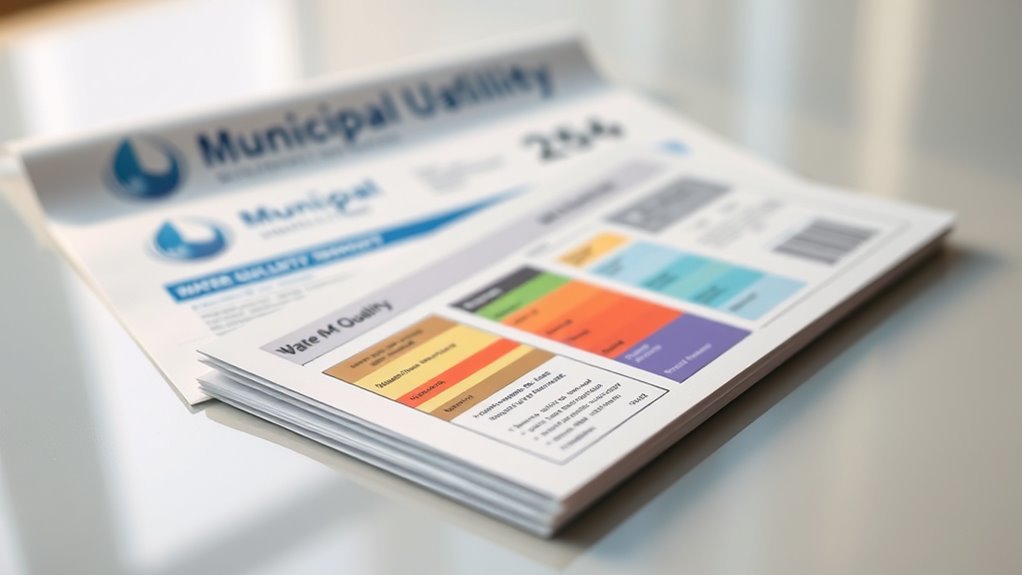Your annual water quality report card provides essential details about your tap water’s safety, including contaminant levels, treatment methods, and potential risks from sources like old pipes or runoff. It helps you understand if your water meets safety standards and suggests steps like flushing or filtering to protect your health. By exploring this information, you’ll gain a clearer picture of your water’s quality and how to keep it safe—learn more to make informed decisions.
Key Takeaways
- The report card details contaminant levels, testing results, and compliance with safety standards for your water supply.
- It explains potential contamination sources like old pipes or runoff and their health implications.
- The letter highlights treatment methods used and suggests household actions such as filters or pipe replacements.
- Monitoring recommendations and year-to-year comparisons help ensure ongoing water safety and quality.
- Understanding these reports empowers consumers to make informed decisions about tap water safety and necessary improvements.

Have you ever wondered how safe your tap water really is? Understanding your water quality report card can help you answer that question. Your annual utility letter provides essential information about your water’s safety and quality, but it can seem overwhelming at first. The report highlights various aspects of tap safety, including any contamination sources that might affect your water. Knowing what to look for empowers you to make informed decisions about your health and your household.
Your water utility is required to test for numerous contaminants, such as bacteria, lead, pesticides, and other chemicals. The report indicates whether your water meets safety standards and if any contaminants were detected during testing. If there are contamination sources present, it’s important to identify their nature, concentration, and whether they pose a health risk. For example, lead can leach into water from old pipes, while agricultural runoff might introduce pesticides or nitrates. Recognizing these sources helps you understand potential vulnerabilities in your tap safety and whether additional precautions are necessary.
Water tests reveal contaminants like bacteria, lead, pesticides, and chemicals, helping identify safety and vulnerability sources.
The report often includes a list of detected contaminants, their levels compared to safety thresholds, and any violations of federal or state standards. If your water exceeds these limits, it’s a sign that you may need to take action, such as installing filters or requesting further testing. The presence of contamination sources doesn’t automatically mean your water is unsafe, but it warrants attention and possibly increased vigilance. It’s important to read the report carefully and understand what each parameter signifies.
Another key element of your water quality report is the explanation of treatment processes used by your utility. Facilities employ various methods—such as chlorination, filtration, or UV treatment—to remove or kill harmful contaminants. Knowing that your utility effectively manages contamination sources reassures you about tap safety. However, if treatment processes are lacking or outdated, you might need to think about additional measures for your household, like installing a home filtration system.
Finally, the report might include recommendations for consumers, such as flushing taps before use, replacing old pipes, or conducting additional testing. These suggestions help you mitigate risks associated with contamination sources, ensuring your tap safety remains high. Staying informed through your annual water quality report card allows you to monitor changes over time, advocate for improvements if necessary, and maintain confidence in your tap water. Additionally, understanding the role of projector technology in testing and treatment processes highlights how advancements in technology contribute to safer water supplies. Remember, understanding this report is a crucial step toward safeguarding your health and making the best choices for your household’s water needs.
Frequently Asked Questions
How Often Is the Water Quality Report Updated?
You might wonder how often your water quality report gets updated. Typically, water utilities perform water sampling regularly, often annually, to detect contamination and guarantee safety. These tests help identify any contamination detection issues early. The report reflects recent sampling results, giving you a clear picture of water quality. So, expect your utility to update the report annually, or more frequently if contamination concerns arise, keeping you informed and safe.
What Do the Different Water Quality Grades Mean?
Ever wonder what those water quality grades really mean? They reflect contaminant levels based on grading criteria set by health standards. A higher grade indicates your water meets safety standards with low contaminant levels, while lower grades signal potential issues needing attention. By understanding these grades, you can better assess your water’s safety and ensure it’s healthy for your family. So, do you know what your current water quality grade is?
Can I Request a Detailed Analysis of My Local Water?
You can request a detailed analysis of your local water by contacting your water utility or local health department. They often conduct water testing and can provide a contaminant analysis upon request. Simply ask for a copy of their recent water quality report or inquire about specific tests for contaminants like lead, bacteria, or chemicals. This way, you stay informed about your water’s safety and address any concerns proactively.
How Are Water Contaminants Tested For?
Did you know over 90% of water samples undergo rigorous testing? When it comes to water testing, labs use advanced methods like chemical analysis, biological testing, and physical assessments to detect contaminants. These techniques guarantee accurate contaminant detection, helping identify impurities such as bacteria, heavy metals, or pesticides. By understanding these processes, you can better appreciate how water utilities keep your water safe and clean.
What Actions Are Taken if Water Quality Issues Are Found?
When water quality issues are found, you can expect your utility to take immediate action to address contamination prevention. They might increase water treatment processes, such as adding disinfectants or filtering systems, to eliminate contaminants. In some cases, they may issue boil water advisories or provide alternative supplies. These steps help guarantee your water remains safe and clean, prioritizing your health and maintaining compliance with safety standards.
Conclusion
Think of your water quality report card as a trusted map guiding you through a hidden landscape. It reveals the secrets of your water’s journey, highlighting strengths and warning of dangers. By understanding this map, you become the vigilant traveler, ensuring your well-being and safety. Embrace this allegory, and let your awareness be the compass that keeps your household on a safe, clear path—because knowledge turns the unknown into a navigable adventure.









